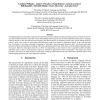Free Online Productivity Tools
i2Speak
i2Symbol
i2OCR
iTex2Img
iWeb2Print
iWeb2Shot
i2Type
iPdf2Split
iPdf2Merge
i2Bopomofo
i2Arabic
i2Style
i2Image
i2PDF
iLatex2Rtf
Sci2ools
LREC
2010
2010
The Cambridge Cookie-Theft Corpus: A Corpus of Directed and Spontaneous Speech of Brain-Damaged Patients and Healthy Individuals
Investigating differences in linguistic usage between individuals who have suffered brain injury (hereafter patients) and those who haven't can yield a number of benefits. It provides a better understanding about the precise way in which impairments affect patients' language, improves theories of how the brain processes language, and offers heuristics for diagnosing certain types of brain damage based on patients' speech. One method for investigating usage differences involves the analysis of spontaneous speech. In the work described here we construct a text corpus consisting of transcripts of individuals' speech produced during two tasks: the Boston-cookie-theft picture description task (Goodglass and Kaplan, 1983) and a spontaneous speech task, which elicits a semi-prompted monologue, and/or free speech. Interviews with patients from 19yrs to 89yrs were transcribed, as were interviews with a comparable number of healthy individuals (20yrs to 89yrs). Structural br...
Brain Processes Language | Education | Impairments Affect Patients | LREC 2010 | Spontaneous Speech |
| Added | 29 Oct 2010 |
| Updated | 29 Oct 2010 |
| Type | Conference |
| Year | 2010 |
| Where | LREC |
| Authors | Caroline Williams, Andrew Thwaites, Paula Buttery, Jeroen Geertzen, Billi Randall, Meredith A. Shafto, Barry Devereux, Lorraine K. Tyler |
Comments (0)

